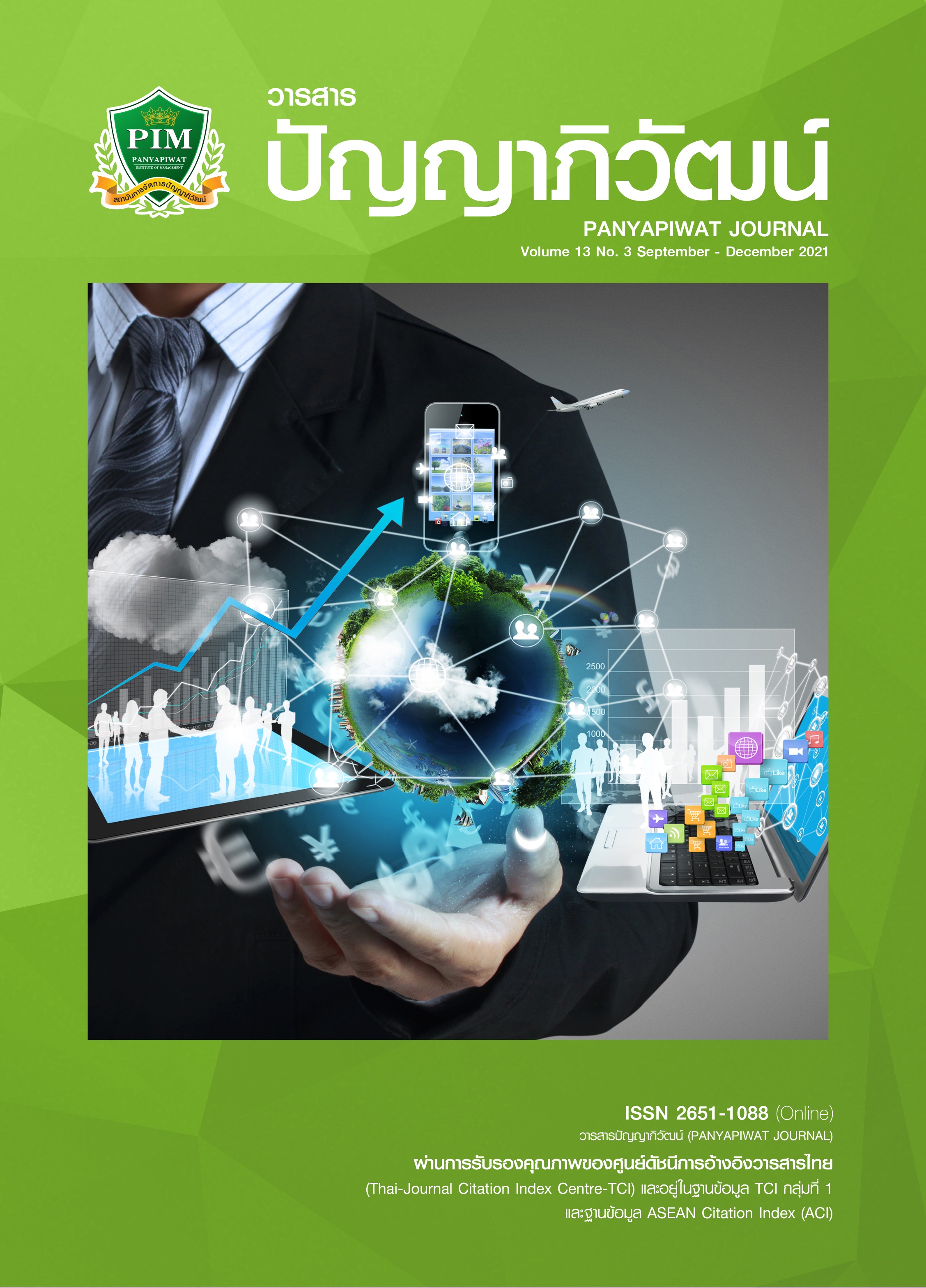A CHANGE IN EDUCATIONAL ADMINISTRATION THROUGH A BUSINESS APPROACH: AN EFFECTIVE LEADERSHIP PERSPECTIVE
Main Article Content
Abstract
This academic paper describes how a new leadership perspective can help to facilitate a change for educational administration through integrating a business approach called the five rules of leadership code. This approach helps the educational organizations survive in this rapidly changing world. Leadership, leadership code framework, the need to change of management, and factors for improvement (i.e. credibility, culture of the organization, confidence, communicative, and collaborative competences) are discussed as they help to enhance changes in the educational organization through a business approach. In a perspective of effective leadership, this new business approach is supposed to present a modern aspect of management in the educational organizations by comparing to the past. It provides more effective solutions in this time of disruptive world environment when a change is essential. To have a positive and effective change in the organization, it requires having an effective leader to lead a change into the correct way.
Article Details

This work is licensed under a Creative Commons Attribution-NonCommercial-NoDerivatives 4.0 International License.
I and co-author(s) certify that articles of this proposal had not yet been published and is not in the process of publication in journals or other published sources. I and co-author accept the rules of the manuscript consideration. Both agree that the editors have the right to consider and make recommendations to the appropriate source. With this rights offering articles that have been published to Panyapiwat Institute of Management. If there is a claim of copyright infringement on the part of the text or graphics that appear in the article. I and co-author(s) agree on sole responsibility.
References
Abou-Moghli, A. (2015). The Role of Organizational Support in Improving Employee’s Performance. International Business Research, 8(2), 198-203.
Atkinson, P. & Mackenzie, R. (2015). Without Leadership There is No Change. Management Services, 59(2), 42-47.
Avolio, B. J. & Gardner, W. L. (2005). Authentic Leadership Development: Getting to the Root of Positive Forms of Leadership. The Leadership Quarterly, 16(3), 315-338.
Baczek, K. (2013). Effective Leadership in Thailand: Exploratory Factor Analysis of Creativity, Need for Achievement, Emotional Intelligence, and Diversity. Retrieved March 8, 2019, from http://www.lse.ac.uk/asiaResearchCentre/_files/ThaiGovScholarKamilaBaczek.pdf
Dan, C. (2010). Development of a Model to Enhance Effective Change Management in Education for Sustainable Development in Higher Education Institution, Can Tho University, Vietnam. Journal of Education Naresuan University, 12, 49-70.
Friedman, B. A. (2007). Globalization Implications for Human Resource Management Roles. Employee Responsibilities and Rights Journal, 19(3), 157-171.
Gilley, A., Dixon, P., & Gilley, J. W. (2008). Characteristics of Leadership Effectiveness: Implementing Change and Driving Innovation in Organizations. Human Resource Development Quarterly, 19(2), 153-169.
Hritz, C. (2008). Change Model. Leadership Excellence, 25(5), 14.
Khan, U. R. (2016). The Role of Leadership on Organizational Change. International Journal of Management Science and Business Research, 5(11), 88-95.
Kuchler, W. (2008). Perceived Leadership Behavior and Subordinates’ Job Satisfaction in Midwestern NCAA Division III athletic departments. The Sport Journal, 11(2), Unpaginated.
Lee, D. (2013). Nokia: The Rise and Fall of a Mobile Giant. Retrieved March 14, 2019, from https://www.bbc.com/news/technology-23947212
Lorenzoni, I., Nicholson-Cole, S., & Whitmarsh, L. (2007). Barriers Perceived to Engaging with Climate Change Among the UK Public and Their Policy Implications. Global Environment Change, 17(3), 445-459.
Mala, D. (2017). Private Schools at Risk of Closure. Retrieved June 12, 2020, from https://www.bangkokpost.com/thailand/general/1206605/private-schools-at-risk-of-closure
Northouse, P. G. (2010). Leadership: Theory and Practice (5th ed). Thousand Oaks: SAGE Publications.
O’Connor, J. & Nguyen, S. (2018). The Pervasive Problem of Debt in Thailand and the Struggle to Survive for Those Hit by Bad Fortune. Retrieved June 13, 2020, from https://www.thaiexaminer.com/thai-news-foreigners/2018/10/08/debt-in-thailand-loans-bankruptcyteachers/
Park, Y. K., Song, J. H., Yoon, S. W., & Kim, J. (2014). Learning Organization and Innovative Behavior: The Mediating Effect of Work Engagement. European Journal of Training and Development, 38(2), 75-94.
Results-Based Leadership Group (RBL Group). (2010). Leadership Code: What is Leadership. Retrieved August 9, 2019, from https://michiganross.umich.edu/sites/default/files/uploads/RTIA/pdfs/dulrich_wp_what_is_leadership.pdf
Saengpassa, C. (2015). Private Schools on Shaky Ground. Retrieved June 12, 2020, from https://www.nationthailand.com/national/30251681
Stacey, M. C., Paul, J. T., & Alice, C. (2011). Trust and Distrust in Safety Leadership: MirrorReflections? Safety Science, 49(9), 1208-1214.
Tangkitvanich, S. (2013). Setting Up Future Failure. Retrieved July 1, 2020, from https://www.bangkokpost.com/opinion/opinion/342521/education-system-ills-setting-up-future-failure
Ulrich, D. & Smallwood, N. (2007). Leadership Brand: Developing Customer-focused Leaders to Drive Performance and Build Lasting Value. Boston, MA: Harvard Business School Publishing.
Ulrich, D., Smallwood, N., & Sweetman, K. (2008). The Leadership Code: Five Rules to Lead By. Boston: Harvard Business School Publishing.
Ulrich, D., Zenger, J., & Smallwood, N. (1999). Results Based Leadership. Boston, MA: Harvard Business School Press.
Vroom, V. H. & Jago, A. G. (2007). The Role of the Situation in Leadership. American Psychologist, 62(1), 17-24.
Wasim, A. & Imran, A. (2010). The Role of Leadership in Organizational Change. Logistics and Innovation Management, 3(2), 9.
Webber, M. (2015). Why I Don’t Use the “Be, Know, Do” Model of Leader Development. Retrieved June 12, 2020, from https://healthyleaders.com/why-i-dont-use-the-be-knowdo-model-of-leader-development/
Wuestman, D. & Casey, J. (2015). Lean Leadership: Sustaining Long-term Process Change. Strategic Finance, 96(8), 15-16.
Yukl, G. A. (2010). Leadership in Organizations. New York: Prentice Hall.
Yukongdi, V. (2010). A Study of Thai Employees’ Preferred Leadership Style. Asia Pacific Business Review, 16(1), 161-181.


